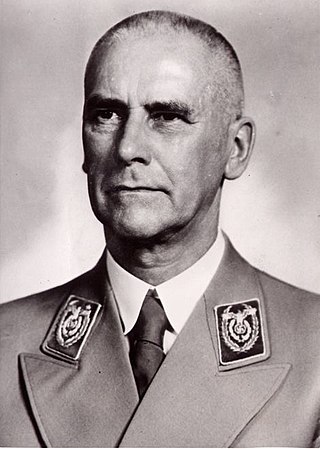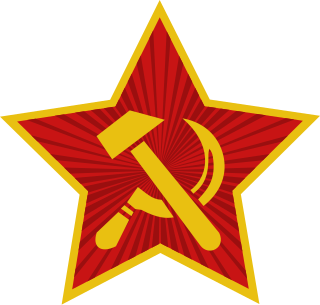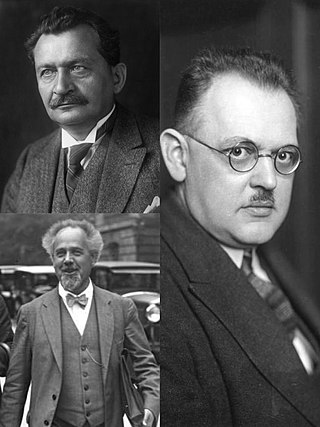The Nazi term Gleichschaltung or "coordination" was the process of Nazification by which Adolf Hitler and the Nazi Party successively established a system of totalitarian control and coordination over all aspects of German society and societies occupied by Nazi Germany "from the economy and trade associations to the media, culture and education". Although the Weimar Constitution remained nominally in effect until Germany's surrender following World War II, near total Nazification had been secured by the 1935 resolutions approved during the Nuremberg Rally, when the symbols of the Nazi Party and the state were fused and German Jews were deprived of their citizenship.

The Weimar Republic, officially known as the German Reich, was a historical period of Germany from 9 November 1918 to 23 March 1933, during which it was a constitutional federal republic for the first time in history; hence it is also referred to, and unofficially proclaimed itself, as the German Republic. The period's informal name is derived from the city of Weimar, which hosted the constituent assembly that established its government. In English, the republic was usually simply called "Germany", with "Weimar Republic" not commonly used until the 1930s.

Wilhelm Frick was a prominent German politician of the Nazi Party (NSDAP), who served as Minister of the Interior in Adolf Hitler's cabinet from 1933 to 1943 and as the last governor of the Protectorate of Bohemia and Moravia.

The Reichstag Fire Decree is the common name of the Decree of the Reich President for the Protection of People and State issued by German President Paul von Hindenburg on the advice of Chancellor Adolf Hitler on 28 February 1933 in immediate response to the Reichstag fire. The decree nullified many of the key civil liberties of German citizens. With Nazis in powerful positions in the German government, the decree was used as the legal basis for the imprisonment of anyone considered to be opponents of the Nazis, and to suppress publications not considered "friendly" to the Nazi cause. The decree is considered by historians as one of the key steps in the establishment of a one-party Nazi state in Germany.

The Enabling Act of 1933, officially titled Gesetz zur Behebung der Not von Volk und Reich, was a law that gave the German Cabinet – most importantly, the Chancellor – the powers to make and enforce laws without the involvement of the Reichstag or Weimar President Paul von Hindenburg, leading to the rise of Nazi Germany. Critically, the Enabling Act allowed the Chancellor to bypass the system of checks and balances in the government.

The Communist Party of Germany was a major far-left political party in the Weimar Republic during the interwar period, an underground resistance movement in Nazi Germany, and a minor party in West Germany during the postwar period until it was banned by the Federal Constitutional Court in 1956.

The German National People's Party was a national-conservative and right-wing populist political party in Germany during the Weimar Republic. Before the rise of the Nazi Party, it was the major conservative and nationalist party in Weimar Germany. It was an alliance of German conservative, German nationalist, supporters of the German monarchy, völkisch, and antisemitic elements supported by the Pan-German League. Ideologically, the party was described as subscribing to authoritarian conservatism, German nationalism, and from 1931 onwards also to corporatism in economic policy. It held anti-communist, anti-Catholic, antisemitic, and monarchist views. On the left–right political spectrum, it belonged on the right-wing, and is classified as far-right in its early years and then in the 1930s when it moved further rightward.
The early timeline of Nazism begins with its origins and continues until Hitler's rise to power.

Federal elections were held in Germany on 5 March 1933, after the Nazi seizure of power on 30 January 1933 and just six days after the Reichstag fire. The election saw Nazi stormtroopers unleash a widespread campaign of violence against the Communist Party (KPD), left-wingers, trade unionists, the Social Democratic Party, and the Centre Party. They were the last multi-party all-German elections until 1990.

Federal elections were held in Germany on 20 May 1928. The Social Democratic Party of Germany (SPD) remained the largest party in the Reichstag after winning 153 of the 491 seats. Voter turnout was 75.6%.

Adolf Hitler's rise to power began in the newly established Weimar Republic in September 1919 when Hitler joined the Deutsche Arbeiterpartei. He rose to a place of prominence in the early years of the party. Being one of its most popular speakers, he was made the party leader after he threatened to otherwise leave.

The Reichstag of the Weimar Republic (1919–1933) was the lower house of Germany's parliament; the upper house was the Reichsrat, which represented the states. The Reichstag convened for the first time on 24 June 1920, taking over from the Weimar National Assembly, which had served as an interim parliament following the collapse of the German Empire in November 1918.

The Reichstag, officially the Greater German Reichstag after 1938, was the national parliament of Nazi Germany from 1933 to 1945. Following the Nazi seizure of power and the enactment of the Enabling Act of 1933, it functioned purely as a rubber stamp for the actions of Adolf Hitler's dictatorship — always by unanimous consent — and as a forum to listen to Hitler's speeches. In this purely ceremonial role, the Reichstag convened only 20 times, the last on 26 April 1942. The President of the Reichstag throughout this period was Hermann Göring.
The Provisional Law and Second Law on the Coordination of the States with the Reich were two laws enacted by the German government of Adolf Hitler to expand its control over the seventeen German states (länder). The Provisional (First) Law dissolved all the sitting landtage, except for that of Prussia, and reconstituted them in accordance with the results of the recent parliamentary election of 5 March 1933, which had given the Nazi Party and its coalition partner, the German National People's Party (DNVP), a majority of the Reichstag seats. The Second Law established the new powerful position of Reichsstatthalter appointed by the central government to effectively take control of each state administration. The effect of these laws was to undermine the power and influence of all political parties other than the Nazis and the DNVP, and to move Germany significantly away from being a federal republic and put it on a path to becoming a unitary state.
Nazi Party Election Results presents a series of tables that summarize the election results of the Nazi Party in German national and state elections. They display the number of votes received, the percentage of the vote, the Party's numerical ranking, the number of parliamentary seats won and the change in the number of seats.
The National Socialist Working Association, sometimes translated as the National Socialist Working Community was a short-lived group of about a dozen Nazi Party Gauleiter brought together under the leadership of Gregor Strasser in September 1925. Its full name was the Arbeitsgemeinschaft der nord- und westdeutschen Gaue der NSDAP. Aligned with the Strasserist wing of the Party, it unsuccessfully sought to steer the Party leadership in that direction by updating the Party program of 1920. Party Chairman Adolf Hitler perceived the Association as a threat to his leadership, so its activities were curtailed shortly after the Bamberg Conference of 14 February 1926 presided over by him, and it was formally dissolved on 1 October of that year.
The Law on the Reconstruction of the Reich of 30 January 1934, was a sweeping constitutional change to the structure of the German state by the government of Nazi Germany. It was one of the key pieces of legislation that served as the basis for the policy of Gleichschaltung, or coordination, by which Adolf Hitler and the Nazi Party successfully established their totalitarian control over all aspects of the German government and society. The law abolished the independent parliaments (Landtage) of the then-extant 16 German states, transferred the states' sovereignty to the central government and essentially converted Germany from a federal republic to a unitary state.
The Law Concerning the Head of State of the German Reich was a statute enacted by the government of Nazi Germany on 1 August 1934 that consolidated the positions of Reich President and Reich Chancellor in the person of Adolf Hitler.
The Law to Secure the Unity of Party and State, sometimes translated as the Law to Safeguard the Unity of Party and State, was a statute enacted by the government of Nazi Germany on 1 December 1933 that established a close interconnection between the Nazi Party and the governmental apparatus of Germany.











